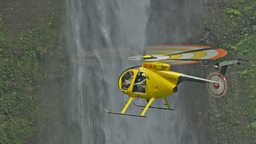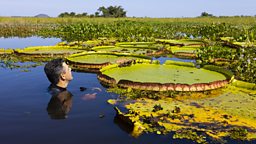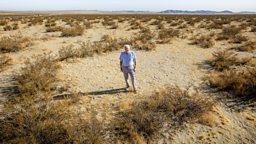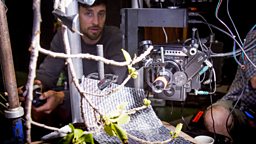10 weird and wonderful plants from The Green Planet
1. Rafflesia - The corpse flower
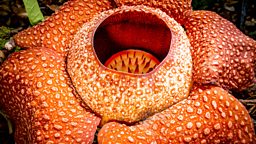
it mimics the dead body of a mammal
Rafflesia (Rafflesia keithii), Borneo. This plant has no stem or leaves, instead it is a parasite on a vine. By feeding on its host, rafflesia is able to produce the world's biggest flower, a metre across. Its success depends on deception – it mimics the dead body of a mammal, from its texture and colour to the scent of rotting flesh. This attracts carrion flies. As a fly searches deeper into the flower, seeking dead flesh upon which to lay its eggs, the flower attaches a gloopy drop of pollen to the fly's back, which, with some luck, will carry it to the next Rafflesia flower to pollinate it.
2. Euphrates poplar - Desert survivors

These trees can live to be over a thousand years old
A Euphrates poplar tree (Populus euphratica), Taklimakan Desert, China. These trees can live to be over a thousand years old. They survive as clones with their roots connected beneath the sand. So when one tree finds water, it can be shared with its neighbours.
3. Tristerix - The body snatcher

it bursts out of its host's skin
The flowers of tristerix (Tristerix aphyllus) Chile. Tristerix is a parasitic plant that infects hedgehog cacti (Echinopsis chiloensis), it bursts out of its host's skin to produce flowers which are pollinated by hummingbirds. These then produce fruit that is eaten by a mockingbird and carried to another host in its droppings.
大象传媒 Screenshot
4. Giant water lily - Monster from the deep
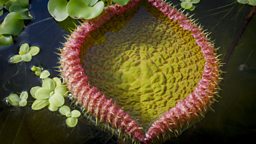
they pierce and crush any competitors
The giant water lily (Victoria cruziana), Pantanal, Brazil. From the muddy lake bottom it shoots up a club-like bud - loaded with vicious spines which protect it from plant-eating animals. On reaching the surface the bud, on its long stem, sweeps across the water surface, pushing competing plants out of the way, before it unfurls into a giant leaf, up to 2.5 metres across. Now the spines become offensive weapons and they pierce and crush any competitors that get in the way.
5. Giant sequoia - The worlds biggest trees
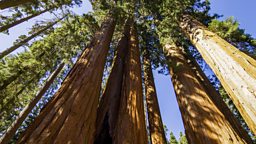
the largest trees on Earth
A giant sequoia (Sequoiadendron giganteum) in the mountains of California. These are the largest trees on Earth. They can grow to nearly 100 metres tall, 11 metres wide and can live for over 3,000 years. Each tree needs 4,000 litres of water every day and for this they rely on seasonal snow melt. But increasingly long, hot summers due to climate change have affected this water supply and now these giants of the natural world are suffering.
6. Saguaro cactus - The shapeshifter
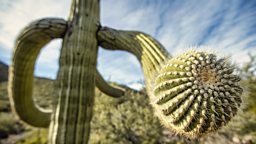
can store 5,000 litres of water
Saguaro cactus (Carnegiea gigantea), Sonoran desert, Arizona. A mature saguaro can store 5,000 litres of water. To accommodate this it has pleats, like an accordion, that run up its trunk and along its arms. After rain the saguaro expands, and the pleats flatten, as the internal water tank is filled. Saguaros are a keystone species in the Sonoran desert providing a place to nest, crucial shade, and food for countless animals. They can live to be over 200 years old.
7. Ceratocaryum - The dung plant

the seeds trick dung beetles
Ceratocaryum (Ceratocaryum argenteum), South Africa. It urgently needs to get its seeds underground before it gets too hot. To do this, the seeds trick dung beetles. The beetles smell out, roll and then bury antelope dung, before laying eggs on it. The beetles’ grubs will then feed on the dung in the cool, underground. Certaocaryum seeds are the same size and have the same texture and scent as antelope dung. So effective is this mimicry that the dung beetles roll the seeds and even bury them at exactly the depth that they need in order to germinate and grow successfully.
8. Creosote bush - The time traveller

One of the oldest organisms on Earth
The creosote bush (Larrea tridentata) survives in the Mojave, North America’s driest desert, by growing extremely slowly - only when water is available. This individual plant is over 10,000 years old. One of the oldest organisms on Earth.
9. Dipterocarp - Worlds biggest seed nursery
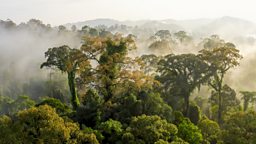
they buy time for a few lucky seeds
Dipterocarps (Dipterocarpacea), Borneo. These are the tallest tropical trees - some tower over 90 metres high. When it comes to reproduction their strategy is to wait. A tree can remain barren of seed for as long as 7 years, but when just the right climatic conditions come along it triggers the all the dipterocarps in the forest to produce billions of seeds all at the same time. This is known as a masting event and it’s a strategy that enables the trees to swamp seed eaters, like bearded pigs, with more seeds than they could eat, and in doing so they buy time for a few lucky seeds to take root and grow before they can be found.
10. Ecballium - The squirting cucumber
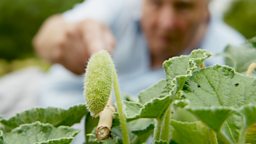
The pod can travel up to 10 metres
The squirting cucumber (Ecballium elaterium) UK. As it ripens, the fleshy tissue inside the plant's pods, which contain its seeds, becomes engorged with liquid. After several weeks the pressure inside is as great as a well-pumped bicycle tyre, and it takes just the slightest disturbance for the pod to blast away from its stalk. As it shoots through the air the pressurised liquid and seeds squirt out through the rupture hole. The pod can travel up to 10 metres, spreading the seeds away from the parent plant, which reduces competition between parent and offspring for space and resources.

